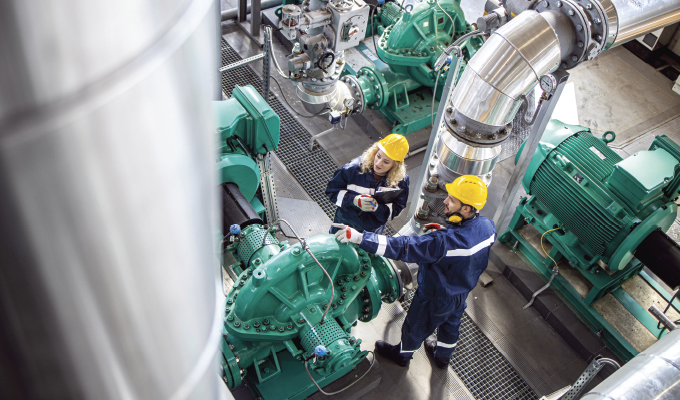When you hear of industries pledging to meet “net zero” guidelines with regard to emissions output, you’d be forgiven for interpreting that as a reducing the size of the power sector. However, through innovation and investment, reshaping our energy grids to achieve net zero targets should be a boom time for the industry as a whole—but time is of the essence.
For example, GE Vernova’s recent study, “Challenges in the Electricity Market: 2025-50: Reaching Net Zero Carbon in Great Britain,” reveals that if urgent action is not taken within the next three years to accelerate investment, additional build-out of renewable, decarbonized generation, and electrical grid, transmission, and distribution infrastructure, Great Britain would be at risk of falling short on its target to supply decarbonized electricity by 2035. And think of Great Britain as just a sample for the energy economy as a whole.
EXPLORING THE TEST CASE
The study examines alternative energy generation and transmission investment scenario pathways considering the economic build-out of renewables, nuclear, storage, and lower carbon thermal generation across Great Britain.
The analysis shows that:
- an additional 250GW of renewable and decarbonized generation will need to be added to the system.
- nuclear and gas power continuing to play an important role due to their reliability and grid congestion management characteristics.
- significant upgrade of grid infrastructure and operations will be required in addition to what is currently envisioned.
With the expectation that electricity demand will double (300-600 terawatt-hour) by 2050, including electrification of heating, transportation, and industry to meet the decarbonization goals, the study shows that an additional 250 GW of renewable and decarbonized generation, approximately 2.5 times that of existing capacity, will need to be added to the power system by 2050 across Great Britain.
About two-thirds of the new capacity is expected to be wind and solar, with nuclear, abated gas, and battery storage all playing an important role to accommodate for the intermittency of renewables and grid congestion.
MEETING THE TARGET
To meet the 2035 target and ensure secure, zero-carbon and affordable energy, Great Britain urgently needs an electricity market design that allows early-stage investment into renewable, lower carbon technologies, and the expansion of the electrical grid system. It is incumbent on policymakers to incentivize private capital providers with clear investment signals through net zero legislation and regulation as there is no silver bullet that will fast forward Great Britain’s electricity system to 2035 and deliver the net zero target. Forming private-public funding partnerships will be the cornerstone of adding additional capacity and expanding the grid at speed.
It is critical to enable and accelerate investments in a combination of electricity generation, transmission, and system control or management technologies with supportive policy and regulatory measures, such as rapid permitting. The study estimates that more than $60 billion of investment, twice as much as invested the past five years, is required in generation and storage capacity alone by 2030. Furthermore, the study suggests accelerating build out of committed capacity for this decade and additional capacity of new generation earmarked for the next decade to be delivered by 2030.
POWERING THE FUTURE
Significant upgrade and expansion of the transmission capability will be inevitable to securely deliver energy from various generation sources to consumers from across Great Britain. In total, around 80GW of additional transmission line capacity across the Scottish and English boundaries will be required to alleviate congestion, avoid curtailment of renewable electricity, and save circa $97 billion in cost to generate electricity by 2050.
This needs to happen along with expediting market reforms that are technology agnostic. Progress on the key recommendations need to happen within the next three years to mitigate the risk of Great Britain falling short of achieving a decarbonized power system by 2035 and the 2050 net zero target.
RESEARCH METHODOLOGY
Credible least cost pathways of future generation and transmission investment in Great Britain were developed utilizing assumptions of the UK electricity system from prominent public sources and an industry accepted modelling platform. The scenarios serve to illustrate how power plants under each pathway would operate to meet demand in the future and the implication on the system as a whole, in particular in relation to the transmission network. The model captures all existing and future power plant on the Great Britain system along with a simplified representation of the interconnection with neighboring countries.
CHALLENGES IN THE ELECTRICITY MARKET: KEY TAKEAWAYS
- Additional 250 GW of renewable and decarbonized generation, approximately 2.5 times that of existing capacity, will need to be added to the power system.
- More than $60 billion of investment, twice as much as that of the past five years, is required in power generation and storage capacity alone this decade.
- 80 GW additional transmission line capacity is required to optimize use of renewable electricity.
FOR MORE INFORMATION
Martin O’Neil is vice president of strategy at GE Vernova’s Gas Power business. GE Gas Power, an integral part of GE Vernova, is a world leader in natural gas power technology, services, and solutions. Through relentless innovation and continuous collaboration with customers, GE Gas Power is providing more advanced, cleaner, and efficient power that people depend on today and building the energy technologies of the future. With the world’s largest installed base of gas turbines and more than 670 million operating hours across GE’s installed fleet, the company offers advanced technology and a level of experience that’s unmatched in the industry to build, operate, and maintain leading gas power plants. For more information, visit www.gepower.com.
MODERN PUMPING TODAY, November 2023
Did you enjoy this article?
Subscribe to the FREE Digital Edition of Modern Pumping Today Magazine!


